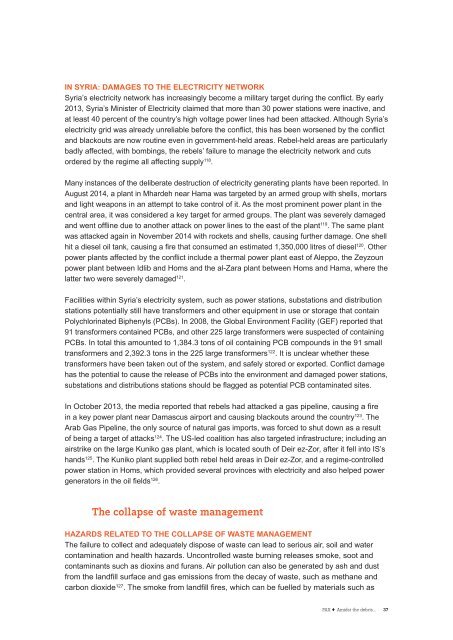Amidst the debris..
pax-report-amidst-the-debris-syria-web
pax-report-amidst-the-debris-syria-web
You also want an ePaper? Increase the reach of your titles
YUMPU automatically turns print PDFs into web optimized ePapers that Google loves.
IN SYRIA: DAMAGES TO THE ELECTRICITY NETWORK<br />
Syria’s electricity network has increasingly become a military target during <strong>the</strong> conflict. By early<br />
2013, Syria’s Minister of Electricity claimed that more than 30 power stations were inactive, and<br />
at least 40 percent of <strong>the</strong> country’s high voltage power lines had been attacked. Although Syria’s<br />
electricity grid was already unreliable before <strong>the</strong> conflict, this has been worsened by <strong>the</strong> conflict<br />
and blackouts are now routine even in government-held areas. Rebel-held areas are particularly<br />
badly affected, with bombings, <strong>the</strong> rebels’ failure to manage <strong>the</strong> electricity network and cuts<br />
ordered by <strong>the</strong> regime all affecting supply 118 .<br />
Many instances of <strong>the</strong> deliberate destruction of electricity generating plants have been reported. In<br />
August 2014, a plant in Mhardeh near Hama was targeted by an armed group with shells, mortars<br />
and light weapons in an attempt to take control of it. As <strong>the</strong> most prominent power plant in <strong>the</strong><br />
central area, it was considered a key target for armed groups. The plant was severely damaged<br />
and went offline due to ano<strong>the</strong>r attack on power lines to <strong>the</strong> east of <strong>the</strong> plant 119 . The same plant<br />
was attacked again in November 2014 with rockets and shells, causing fur<strong>the</strong>r damage. One shell<br />
hit a diesel oil tank, causing a fire that consumed an estimated 1,350,000 litres of diesel 120 . O<strong>the</strong>r<br />
power plants affected by <strong>the</strong> conflict include a <strong>the</strong>rmal power plant east of Aleppo, <strong>the</strong> Zeyzoun<br />
power plant between Idlib and Homs and <strong>the</strong> al-Zara plant between Homs and Hama, where <strong>the</strong><br />
latter two were severely damaged 121 .<br />
Facilities within Syria’s electricity system, such as power stations, substations and distribution<br />
stations potentially still have transformers and o<strong>the</strong>r equipment in use or storage that contain<br />
Polychlorinated Biphenyls (PCBs). In 2008, <strong>the</strong> Global Environment Facility (GEF) reported that<br />
91 transformers contained PCBs, and o<strong>the</strong>r 225 large transformers were suspected of containing<br />
PCBs. In total this amounted to 1,384.3 tons of oil containing PCB compounds in <strong>the</strong> 91 small<br />
transformers and 2,392.3 tons in <strong>the</strong> 225 large transformers 122 . It is unclear whe<strong>the</strong>r <strong>the</strong>se<br />
transformers have been taken out of <strong>the</strong> system, and safely stored or exported. Conflict damage<br />
has <strong>the</strong> potential to cause <strong>the</strong> release of PCBs into <strong>the</strong> environment and damaged power stations,<br />
substations and distributions stations should be flagged as potential PCB contaminated sites.<br />
In October 2013, <strong>the</strong> media reported that rebels had attacked a gas pipeline, causing a fire<br />
in a key power plant near Damascus airport and causing blackouts around <strong>the</strong> country 123 . The<br />
Arab Gas Pipeline, <strong>the</strong> only source of natural gas imports, was forced to shut down as a result<br />
of being a target of attacks 124 . The US-led coalition has also targeted infrastructure; including an<br />
airstrike on <strong>the</strong> large Kuniko gas plant, which is located south of Deir ez-Zor, after it fell into IS’s<br />
hands 125 . The Kuniko plant supplied both rebel held areas in Deir ez-Zor, and a regime-controlled<br />
power station in Homs, which provided several provinces with electricity and also helped power<br />
generators in <strong>the</strong> oil fields 126 .<br />
The collapse of waste management<br />
HAZARDS RELATED TO THE COLLAPSE OF WASTE MANAGEMENT<br />
The failure to collect and adequately dispose of waste can lead to serious air, soil and water<br />
contamination and health hazards. Uncontrolled waste burning releases smoke, soot and<br />
contaminants such as dioxins and furans. Air pollution can also be generated by ash and dust<br />
from <strong>the</strong> landfill surface and gas emissions from <strong>the</strong> decay of waste, such as methane and<br />
carbon dioxide 127 . The smoke from landfill fires, which can be fuelled by materials such as<br />
PAX ! <strong>Amidst</strong> <strong>the</strong> <strong>debris</strong>...<br />
37


